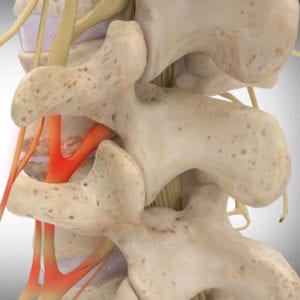Lumbar spinal stenosis (LSS) occurs when there are changes in the shape and size of the spinal canal. As we age, the bones, discs, and joints of the lower back degenerate, causing bulging discs, thickening of spinal ligaments and enlarged joints. Vertebrae may slip out of alignment and rub against each other, causing the growth of bone spurs of the foramen. The constriction of the nerves in the spinal column causes inflammation and the radiating pain associated with LSS.
What are the Symptoms of LSS?
LSS is most common in people over 50 and may continue to progress with age. Not all patients with a narrowed spinal canal experience pain. However, the compression of the lumbar nerves can eventually lead to weakness, tingling, and numbness in the lower back and buttocks, a sensation also known as sciatica.
Lumbar spinal stenosis can also cause a stooped posture because it’s more comfortable to walk when leaning forward slightly, such as with a walker or shopping cart. While it typically occurs in older patients, people suffering from developmental conditions may develop LSS at a younger age.
Nonsurgical Treatments
Oral medications may be used to help reduce inflammation and pain in the lower body. Mild anti-inflammatory pain medications (NSAIDs) and rest may relieve the pain associated with spinal stenosis. Physical therapy, exercise or lumbar transforaminal steroid injections are other conservative treatment options.
Surgical Treatments
If symptoms worsen, your doctor may suggest a surgical procedure like a laminectomy or spinal fusion.
A popular outpatient option, the Vertiflex Superion indirect decompression system, offers patients a less-invasive surgical alternative. The Superion implant acts as a spacer, holding the compressed vertebrae further apart. The restored space relieves the pressure placed on nerves, thus reducing inflammation.

